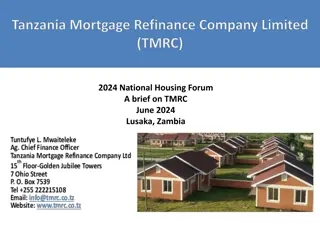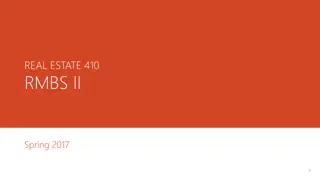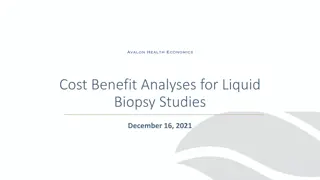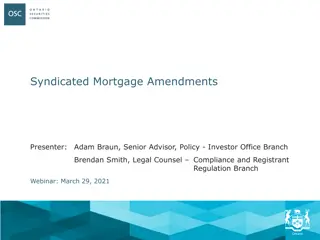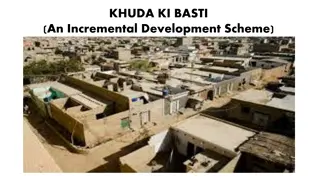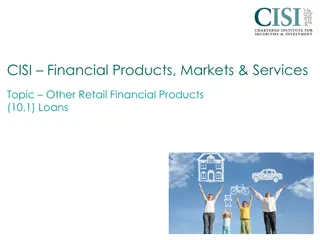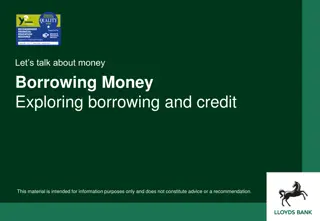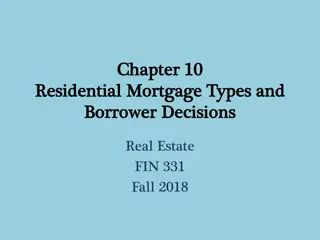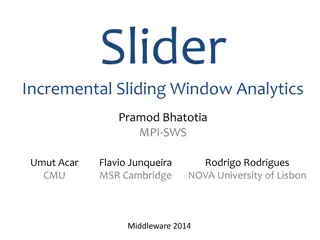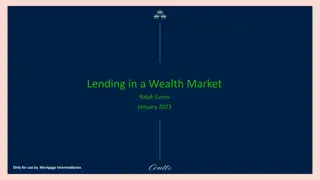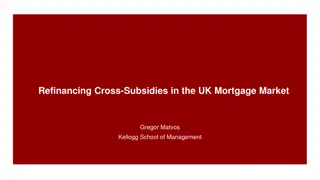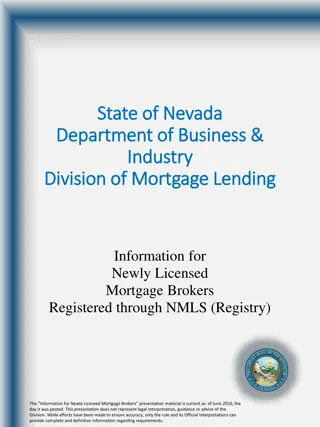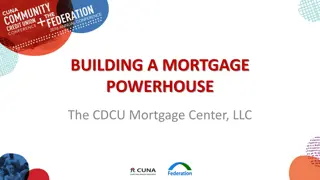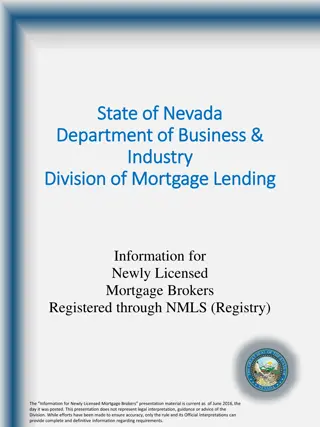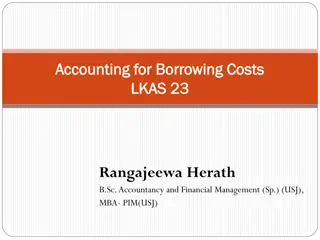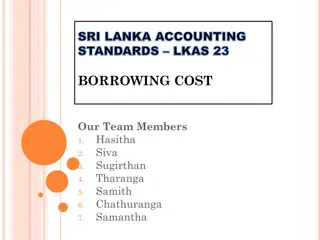Incremental Borrowing Cost Analysis in Mortgage Decision Making
Explore the concept of incremental borrowing cost in the context of mortgage financing decisions. Learn how slight increases in interest rates can impact the overall borrowing cost and affect your financial choices when selecting between different loan options. Dive into a practical example comparing two financing alternatives to understand the real cost implications of incremental borrowing.
Download Presentation

Please find below an Image/Link to download the presentation.
The content on the website is provided AS IS for your information and personal use only. It may not be sold, licensed, or shared on other websites without obtaining consent from the author. Download presentation by click this link. If you encounter any issues during the download, it is possible that the publisher has removed the file from their server.
E N D
Presentation Transcript
REAL ESTATE 410 Additional Mortgage Topics Spring 2017 1
Topics Incremental borrowing cost analysis Mortgage refinancing analysis Early loan repayment Market value of a mortgage Below market financing / cash equivalency Wraparound and buydown loans After-tax effective interest rate Impact of debt Mortgage options 2
Incremental Borrowing Cost As you borrow more money, the interest rate on the loan is bound to increase. E.g., interest rate on a 90% LTV loan higher than that on a 80% LTV loan. Basically, borrowing a little bit more increases the total borrowing cost. The question is then: What is the real cost of borrowing more moneyat a higher interest rate? We need to find the marginal or incremental cost of the borrowing. 3
Incremental Borrowing Cost Example 1 Home value: $150,000 Two financing alternatives: Option 1: 90% LTV ($135,000), 8.5% interest rate, 30 years Option 2: 80% LTV ($120,000), 8% interest rate, 30 years What option to choose, assuming that you can afford the additional $15,000 if required? 4
Incremental Borrowing Cost Solution It appears there is only a 0.5% interest rate increase. BIG DEAL! But what is the real cost of the incremental borrowing of $15,000 if option 1 is selected? This cost should be compared to the opportunity cost of the additional $15,000 downpayment required if option 2 is selected. 5
Incremental Borrowing Cost Solution (cont d) Option 1 90% 8.5% 30 years $15,000 $135,000 $1,038.03 Option 2 80% 8% 30 years $30,000 $120,000 $880.52 LTV Interest rate Term Down payment Loan Payment 6
Incremental Borrowing Cost Solution (Cont d) Cash flow differences: Borrow $15,000 more Pay $157.51 more per month for 30 years What is the effective interest rate on such loan? PV = $15,000; PMT = -$157.51; n = 360; FV = $0 Then, i = 12.28% Thus the additional borrowing cost is much higher than 8.5%. You need to compare this to the opportunity cost of the additional downpayment or the cost of a 2nd mortgage. Whether you plan to prepay will also matter! 7
Incremental Borrowing Cost Example 1 with Early Repayment Option 1 90% 8.5% 30 years 10 years $15,000 $135,000 $1,038.03 $119,613.44 Option 2 80% 8% 30 years 10 years $30,000 $120,000 $880.52 $105,269.64 LTV Interest rate Term Prepayment Down payment Loan Payment Balance end yr. 10 8
Incremental Borrowing Cost Cash flow differences: Borrow $15,000 more Pay $157.51 more per month for 10 years and repay $14,343.80 at the end of year 10. What is the effective interest rate on the loan? PV = $15,000; PMT = $157.51; n = 120; FV = $14,343.80; Therefore, i = 12.38% Early repayment only slightly increases the cost of additional borrowing in this case. Any prepayment fees would cause cost of borrowing to be even higher. 9
Incremental Borrowing Cost With origination Fee: Option 1 90% 8.5% 30 years 1.5% $15,000 $135,000 $132,975 $1,038.03 Option 2 80% 8% 30 years 1% $30,000 $120,000 $118,800 $880.52 LTV Interest rate Term Origination fee Down payment Loan Loan proceeds Payment 10
Incremental Borrowing Cost Cash flow differences: Borrow $15,000 more, but effectively receive $14,175 Pay $157.51 more per month for 30 years What is the effective interest rate on the loan? PV = $ 14,175; PMT = $157.51; n = 360; FV = $0 Therefore, i = 13.06% Higher origination fees would increase the cost of additional borrowing. The impact would even be higher if the loan is repaid before maturity 11
Incremental Borrowing Cost Incremental borrowing rates must be competitive with interest rates charged on 2nd mortgages. For the previous example the interest rate on 2nd 10% LTV loan above 80% LTV must be less or equal to 12.28% (without fees). Otherwise, the borrower would be better of taking a 90% LTV loan and paying 8.5% interest. In the event the borrower can afford the additional downpayment, she must compare her opportunity cost to the incremental borrowing cost. 12
Marginal vs. Average Costs The interest rate charged on a 90% LTV loan can be viewed as the weighted average of the rate on a 80% LTV loan and the incremental cost of a 10% LTV loan. Since interest rates increase with LTV because of the higher risk of default, marginal interest rate must increase at an even higher rate. This is depicted in example presented next. In general, for the average of a variable to increase, its marginal must lie above and be increasing at an even a higher rate. 13
Marginal vs. Average Costs The interest rate charged on a 90% LTV loan can viewed as the weighted average of the rate on a 80% LTV loan and the incremental cost of a 10% LTV loan. Since interest rates increase with LTV because of the higher risk of default, marginal interest rate must increase at an even higher rate. This is depicted in example presented next. In general, for the average of a variable to increase, its marginal must lie above and be increasing at an even a higher rate. 14
Marginal vs. Average Costs Effect of LTV on Loan Cost: 15
Marginal vs. Average Costs Takeaway: The more you borrow, the higher the interest rate will be. There is a point at which you should not borrow more money. The interest rate will be just too high. It is not economically rational to borrow as much money as possible. 16
Marginal vs. Average Costs Most FRMs mortgages allow borrowers to prepay, with or without penalty, by getting a new loan to pay the old one (this is the prepayment option). But when does mortgage refinancing make sense? Abstracting from equity extraction, exercising the prepayment option only makes sense if mortgage rates are lower and the resulting saving in payments is greater than refinancing costs (i.e., any penalties plus fees on the new loan). The decision hinges on finding the return on the refinancing investment. 17
Refinancing Decision Information required in any refinancing decision. Terms on the present outstanding loan Terms of the new loan being considered Any fees associated with paying off the old loan and obtaining the new loan Likelihood of prepayment With this information in hand, the next step is to compute the return on the refinancing. Three methods: Internal Rate of Return (IRR) Market value of loan Effective cost of borrowing 18
Refinancing: IRR Method The IRR method of analyzing a mortgage refinancing decision involves approaching the decision as an investment decision and computing its IRR. The cost of the investment are all costs faced by the borrower at the time of refinancing that is the cash flow at time 0. This investment will lead to positive cash flows (and maybe negative ones) in the future representing futures payment savings resulting from the lower loan payments. Next, compute the IRR of the stream of cash flows and compare it to your opportunity cost. If the IRR is higher, do the refinancing, otherwise, don t. 19
Refinancing: IRR Method Example 1 15 years ago, a borrower secured a 30-year, $120,000 loan at 7% with monthly payments. The borrower has now the opportunity to refinance the remaining balance on the loan with a 15-year mortgage at 6%. But the new loan requires the payment of up-front fees of $2,500. 1. What is the return on investment if the borrower expects to remain in the home for the next 15 years? Should she refinance the loan? 20
Refinancing: IRR Method Initial Loan: Loan amount: $120,000 Term: 30 Years Interest rate: 7% Payment = $798.36 Loan Balance at end year 15 = $88,822.64 New loan: Loan amount: $88,822.64 Term: 15 years Interest rate: 6% Payment = $749.54 21
Refinancing: IRR Method Refinancing cost = $2,500 Payment savings = 798.36 - 749.54 = $48.82 per month for 15 years Refinancing return: PV = ($2500); FV = $0; PMT = $48.82; n = 180 Then, IRR = 22.62% Technically, it makes sense to refinance whenever refinancing return is greater or equal current market rate. More accurately, the borrower should refinance if return greater or equal to opportunity cost, highest return from alternative investments of similar risk. 22
Refinancing: IRR Method 2. What is the return on investment if the borrower expects to sell the property and relocate after 7 years? Now the calculation is just slightly more complicated because we need to consider the expected future loan balances on the original loan and the refinancing loan 7 years from now, or at the end of year 22. 23
Refinancing: IRR Method Balance on the original loan at the end of year 22 (7 years from now) would be $58,557.76 i = 7%, n = 96, PMT = $798.36 and FV = $0 PV = $58,557.76 Balance on the refinancing loan 7 years from now would be $57,036.41 i = 6%, n = 96, PMT = $749.54 and FV = $0 PV = $57,036.41 Therefore, you would owe $1,521.35 more under the existing loan in 7 years. 24
Refinancing: IRR Method Next, compute the return on the refinancing investment: PV= ($2500) PMT saving = $48.82 FV (balance saving) = $1,521.35 n = 84 IRR = 20.93% Refinancing appears to be a wealth enhancing, unless you have other investments of similar risk that can fetch more than 20.93%. 25
Refinancing: Loan Value Method This alternative method of analysis refinancing decision applies the concept of the market value of a loan. The question to answer is how much would an investor be willing to pay for the loan today given current market conditions? The investor would be buying the cash flow stream of the loan. The market value of the loan would be discounted value of the cash flows at the market rate of interest for investments of equivalent risk. 26
Refinancing: Loan Value Method The next step involves comparing the market value of remaining payments to the loan balance. One should then only refinance if the gain to refinancing is larger than the refinancing costs Loan Value Loan Balance > Refinancing costs The difference between this method and the previous cost-benefit method is that this method assumes the current market rate as the borrower s opportunity cost. 27
Refinancing: Loan Value Method Example 2 Suppose you entered 5 years ago into a 30-year, $500,000 mortgage with monthly payments at an interest rate of 7%. Suppose interest rate drops to 6.5% and you are not planning to sell the house. 1. Should you refinance if refinancing cost is $15,000? 28
Refinancing: Loan Value Method Monthly PMT: PV = $500,000; FV = 0; N = 360; I = 7%; PMT=$3,326.51 Balance currently owed (i.e., end of year 5): PMT=$3,326.51; FV=0; N=300; i=7%; Balance=$470,657.95 Present value of remaining payments at current market rate: PMT=$3,326.51; FV=0; N=300; i=6.5%; Value=$492,665.46 Should you refinance then? Benefit = 492,665.46 - 470,657.95 = $22,007.51 Since the benefit of refinancing is greater than refinancing cost of $15,000, then you should refinance. 29
Refinancing: Loan Value Method 2. Prepayment: Same setup as before, but now you plan to sell the house in 6 years from today. Should you refinance if refinancing cost is still $15,000? Monthly PMT under existing loan: $3,326.51 Current loan balance existing loan: $470,657.95 Loan balance owed in 6 years (i.e., end of year 11): PMT=$3,326.51; FV=0; N=228; i=7% Balance=$418,854.75 30
Refinancing: Loan Value Method The value of mortgage today is the value today (PV) of 72 payments of $3,326.51 to be made in the next 6 years and that of $418,854.75 to be repaid in 6 years. PMT=$3,326.51; N=72; i=6.5%; FV= $418,854.75 Value mortgage = PV = 481,776.69 Benefit = 481,776.69 470,657.95 = $11,118.74 Benefit < Cost. Therefore, do not refinance,assuming that the borrower opportunity cost is the market rate. If lower use the IRR method. 31
Refinancing: Loan Value Method With prepayment in 6 years, it turns out that the IRR of refinancing is negative (-1.71%, check it!), making the refinancing decision relatively easy. When would the IRR be positive even though the PV of savings is less than the cost of refinancing? What to do in that instance? In this instance, IRR will be lower than the market rate used. Can proceed with the refinancing if opportunity cost is lower than IRR Is it necessary that the refinancing loan and the existing loan mature at the same time? Not necessarily 32
Refinancing: Effective Cost Method This method applies the effective borrowing cost concept seen previously to the refinancing problem by deducting refinancing costs from the amount to be refinanced and computing the effective borrowing cost under the new mortgage. It consists of comparing this effective borrowing cost to existing mortgage interest rate. If it is lower, the borrower should then proceed with the refinancing. This method should lead to the same decision as the previous ones. 33
Refinancing: Effective Cost Method Example 3 Back to our previous example: A 30-year, $500,000 CPM mortgage with monthly payments and annual interest rate of 7% signed 5 years ago. Use effective borrowing cost method to explore if borrower should refinance now at current interest rate of 6.5% if refinancing cost is $15,000. Existing Loan: PV = $500,000; FV = 0; N = 360; I = 7%; PMT=$3,326.51 Current Balance: PMT=$3,326.51; FV=0; N=300; i=7%; Balance=$470,657.95 34
Refinancing: Effective Cost Method New Loan: PV = $470,657.95; FV = 0; N = 300; I = 6.5% PMT=$3,177.92 Effective refinancing cost? PV = 470,657-15,000=$455,657 PV= $455,657; PMT=($3,177.92); FV=0; N=300; Then, i=6.85% Since the effective refinancing cost is lower than the interest charged on the existing loan, the borrower should proceed with the refinancing. Show using this method that refinancing would not optimal if the loan will be repaid in 6 yrs. (Answer: i=7.19%) 35
Uses of Cash 37
Early Repayment During periods of rising interest rates, lender may try to induce early repayments by offering discounts on the remaining balance. In this instance, the borrower should compare the discount rate equalizing the PV of remaining payments under the loan to the discount value of the loan balance to her opportunity cost. If the borrower has money lying around, she should only repay if the discount rate is higher than the highest return (for comparable risk) she can earn outside. If the alternative is to borrow to repay the loan, this would most likely not be a better option. 38
Cost of Several Loans Sometimes a borrower may have to choose between getting one loan or two or more loans to finance the purchase of a property. How should that decision be approached? Basic Technique: Compute the payments for the loans Combine payments into a cash flow stream Compute the effective cost of the amount borrowed, given the cash flow stream. Compare the cost to alternative financing options. 39
Cost of Several Loans Example 4 You need a $500,000 financing package to purchase a property. You can get 3 loans with the following characteristics. What is the effective borrowing cost? Loan 1: $100,000 at 7%, 30 years; then payment = $665.30 Loan 2: $200,000 at 7.5%, 20 years; then payment = $1,611.19 Loan 3: $200,000 at 8% 10 years; then payment = $2,426.55 40
Cost of Several Loans Using the cash flow register of your calculator to compute the discount rate CF0 = ($500,000) CF1 = 665.30+1,611.19+2,426.55 = $4,703.04 N1 = 120 CF2 = 665.30+1,611.19 = $2,276.49 N2 = 120 CF3 = $665.30 N3 = 120 Then compute IRR = .6239 x 12 = 7.49% 41
Below Market Financing A seller with a below market rate assumable loan in place may be able to sell the property for more than the seller would otherwise be able to. All else equal, a buyer is paying a higher purchase price now in exchange for lower debt payments over the life of the loan. Similar to other problems, we compute IRR on the additional purchase price amount and compare it to other investments of equivalent risk. 42
Below Market Financing Example 5 Identical Homes A & B A B Price Loan Balance $120,000 $80,000 (assumable) $40,000 7% 20 Years $620.24 $115,000 $80,000 (new loan) $35,000 8% 20 Years $669.15 Down payment Interest Term Payment 43
Below Market Financing The buyer can secure below market financing by paying $5,000 more for an identical home. The below market financing results in a monthly payment of $48.91 less than if regular financing was used. Return on the investment: PV = $5000; FV = $0; PMT = $48.91; n = 240 , Thus, IRR = 10.20% The buyer earns 10.20% on the $5,000 investment by reducing the monthly payment by $48.91. Whether or not it is a good investment depends on your opportunity cost. 44
Cash Equivalency This is another way to analyze below market financing. Rather than computing the return on the additional purchase amount, you compute the market value of the payments under the assumable loan using the current market rate. Compare that value to the remaining balance on the assumable loan. If the difference is higher than the additional cost of the property, then it makes sense to pay the higher price and assume the loan. 45
Cash Equivalency Example 5 (bis) Identical Homes A & B A B Price Loan Balance $120,000 $80,000 (assumable) $40,000 7% 20 Years $620.24 $115,000 $80,000 (new loan) $35,000 8% 20 Years $669.15 Down payment Interest rate Term Payment 46
Cash Equivalency Market value of the remaining payments under the assumable loan: PMT=$620.24; n=240 i=8% FV=0 Thus, PV=$74,152.25 Benefit of assuming loan 80,000-74,152.25= $5,847.75 Since the benefit is greater than the additional cost of $5,000, you should take the assumable if you opportunity cost is the market rate. 47
Wraparound Mortgages Wraparound loans are used to obtain additional financing on a property while keeping an existing loan (with a below market interest rate) in place. The wraparound lender (a different lender) makes a loan for an amount equal to the existing loan balance plus the additional financing. The borrower only makes payments on the wraparound loan, and the wraparound lender makes payments on the existing loan. The wraparound lender does not substitute for the borrower in the first mortgage. 48
Wraparound Mortgages The wraparound lender is in fact providing a 2nd mortgage at a rate that is lower than the rate the first lender would charge on a 2nd mortgage and the incremental cost of borrowing if the lender had provided a refinancing loan for a higher amount. The wraparound lender is not obligated to make payments under the first loan if the borrower misses payments on the wraparound loan. But as 2nd mortgage lender, the wraparound lender may make advances on the 1st lien and add then to the balance of the wraparound loan. 49
Buydown Loans The seller/builder of a property pays an amount to the lender to buy down (lower) the interest rateon the buyer s loan for a specific period of time. This is used to attract buyers during periods of high interest rates. The lower initial rate may make it easier for the buyer to qualify for the loan as well. Typically though, sellers will add the buydown amount to the price of the property. The buyer may be better off negotiating a lower price and paying market rate. Buydown loans are often combined with GPM or ARMs. Buydowns are similar to discount points in the sense that points are supposed to lower rates. 50



